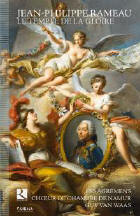Texte paru dans: / Appeared in: |
|
| "Strongly recommended" |
Outil de traduction ~ (Très approximatif) |
|
Reviewer: Barry
Brenesal Voltaire began by disliking Rameau’s music, which he found pedantic. He then decided that the composer’s combination of quality and a penchant for controversy would make him an ideal colleague for the writer’s operatic reforms. And he concluded their final collaborations, forced upon him in the mid-1740s by the Duc de Richelieu to celebrate a dynastic marriage and military victory, with the written opinion that Rameau was a great musician but literarily insane, and impossible for any decent librettist to work with. La Temple de la Gloire was the second of those two works commanded into existence, and meant to celebrate the 1745 French victory at Fontenoy. It was given twice privately in November that year, and then publicly at the Opéra in December, where it failed miserably. The blame was for the most part placed on Voltaire’s shoulders, largely because of his belief that an opéra-ballet shouldn’t contain any love interest, but focus entirely upon high-minded principles—in this case, the kind of behavior that is proper for a ruler, and renders him able to enter Glory’s allegorical temple and sit upon its throne. The second version, which took the stage in April the following year, employed extensive cuts and rewriting. Presumably it was Rameau who suggested the return of a love interest, for the first of the three rulers depicted in the second version, Bélus, reconciles with the woman he had abandoned for a lifestyle of endless war and tyranny. It, too, was a failure, and nothing more was heard of it during the lifetime of either librettist or composer. Voltaire, writing many years later in 1776, noted that “the public found that architecture of this temple was not to their taste; I too did not find it particularly good.” And that was that. Yet the work has much to recommend it. The Prologue, which begins with Envy expressing her hatred of Glory’s temple, is both a fine dramatic aria da capo in its own right, and a dramatic touch, its dark orchestration and spiteful expressiveness following on the heels of the intensely bright, fast-moving figurations of the Overture. The chorus of Bélus’s warriors, with its percussion and trumpets, followed swiftly by the mournful a cappella chorus of shepherds, is yet another such moment of effectiveness; and if, as critics pointed out at the time, Bélus being turned aside from his bellicose rampage by ballets makes little sense, Rameau’s choruses and dances provide all the emotional logic one could desire. There’s a haunting lament of an aria for lost love, “Reviens, divin Trajan”; a fine air for a bacchante, “La brillante Érigone,” with the higher strings accompanying alone, divided and engaging in complex rhythmic figurations; and a mixed chorus of Romans, “Ó grandeur! ó clémence!” that forges rich, slow-moving harmonies into a very impressive celebration of Trajan before Glory’s descent. Much more is worth hearing, especially but not exclusively in the work’s many dances. The performances range from good to excellent, with five singers sharing all the various solo parts. Thus Judith van Wanroij gets to lament twice, her dark mezzo and good breath support making much of Lydie’s “Muses, filles du ciel,” and Plautine’s aforementioned “Reviens, divin Trajan.” Of Mathias Vidal in Campra’s La carnaval de Venise (Glossa 921622), I wrote that his voice didn’t have the ease of production I’ve heard from a few other high tenors, but that his facility was excellent. Here, his tone comes far more easily; he makes a magnificently gleaming sound as Apollo, and a lyrical one in Bacchus’s “Érigone, objet plein de charmes.” Chantal Santon-Jeffrey’s bright tone and fine top make her the right choice for Glory, while Katia Velletaz makes one wish her short airs as a shepherdess and bacchante were somewhat longer, in order enjoy more of her focused, youthful sound and forward enunciation. Alain Buet, whose voice showed some return to form in a recent release of Campra’s Tancréde (Alpha 958), still impresses. There’s no hiding the spread tone, but it no longer conceals the stylishness of this fine artist. Guy van Waas leads Les Agrémens with discipline and spirit. The Chœur de Chambre de Namur in turn—you’ll pardon the expression—cover themselves with glory in managing the complexities Rameau expected of his chorus in this score. They are truly a sixth major performer, and the Namur singers manage it expertly in all their many incarnations, as shepherds, demons, bacchantes, etc. The digest-sized case may annoy some listeners, but it permits lengthy, solid liner notes, in addition to the expected text with English translation. In excellent sound, this isn’t first-tier Rameau, but it’s a fine score that is now realized in an excellent recording. Strongly recommended. | |
|
|
|
|
Cliquez l'un ou l'autre
bouton pour découvrir bien d'autres critiques de CD |
|




